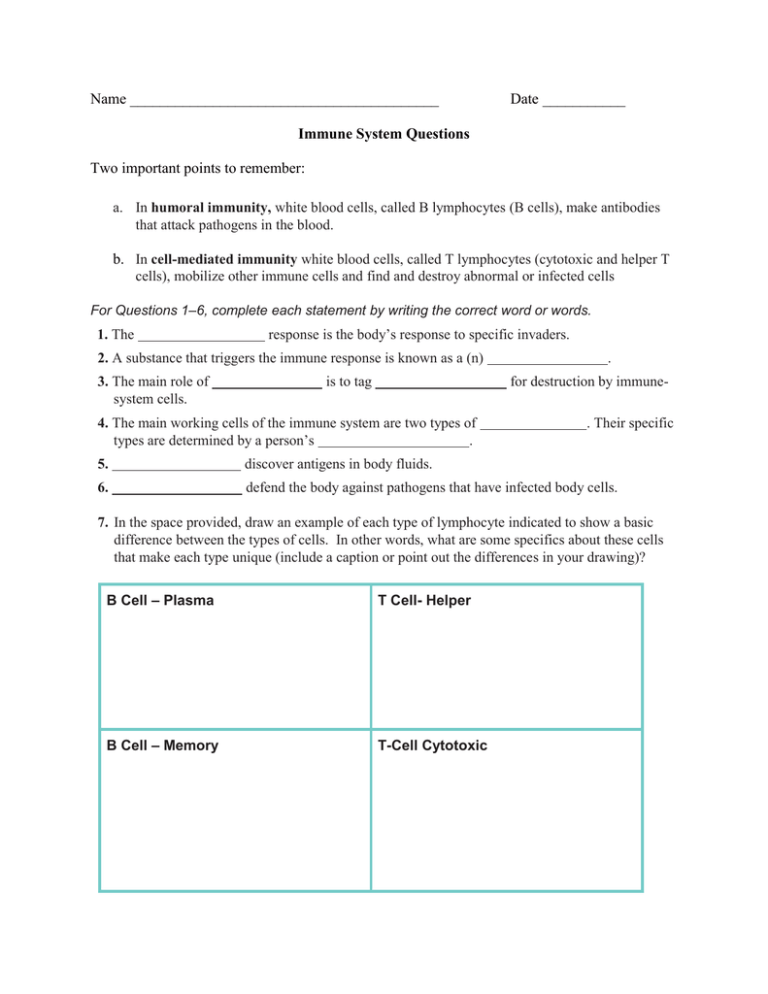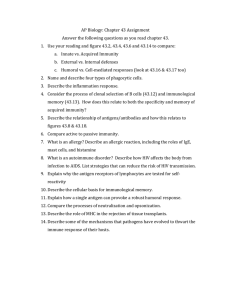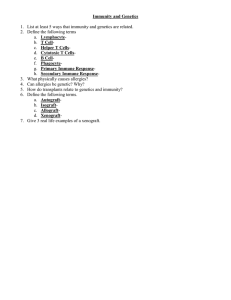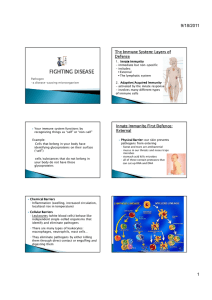Name _________________________________________ ... Two important points to remember: Immune System Questions
advertisement

Name _________________________________________ Date ___________ Immune System Questions Two important points to remember: a. In humoral immunity, white blood cells, called B lymphocytes (B cells), make antibodies that attack pathogens in the blood. b. In cell-mediated immunity white blood cells, called T lymphocytes (cytotoxic and helper T cells), mobilize other immune cells and find and destroy abnormal or infected cells For Questions 1–6, complete each statement by writing the correct word or words. 1. The response is the body’s response to specific invaders. 2. A substance that triggers the immune response is known as a (n) 3. The main role of system cells. is to tag . for destruction by immune- 4. The main working cells of the immune system are two types of types are determined by a person’s . . Their specific 5. discover antigens in body fluids. 6. defend the body against pathogens that have infected body cells. 7. In the space provided, draw an example of each type of lymphocyte indicated to show a basic difference between the types of cells. In other words, what are some specifics about these cells that make each type unique (include a caption or point out the differences in your drawing)? B Cell – Plasma T Cell- Helper B Cell – Memory T-Cell Cytotoxic 8. Complete the table to compare how humoral and cell-mediated immunity work after a virus invades the body for the first and second times. Humoral Immunity vs. Cell-Mediated Immunity Action of Humoral Immunity Primary response: Action of Cell-Mediated Immunity Primary response: Macrophages consume viruses and display their antigens on the cell surface. Helper T cells are activated. Activated B cells grow and divide rapidly. Helper T cells activate B cells and cytotoxic T cells and produce memory cells. Plasma cells release antibodies that capture antigens and mark them for destruction. Secondary response: Secondary response: 9. What type of B cell is produced that acts immediately against antigens once contact with a Thelper cell has occurred. How do these cells stop antigens from infecting other cells? 10. Why don’t cytotoxic T cells associate with macrophages and B-cells like T helper cells do? 11. Considering adaptive immunity, why is the secondary response to a previously identified pathogen so much faster than the primary response? 12. Identify at least three types of cell communication involved in the immune response, these could be in the innate or adaptive/acquired parts of the system. 13. Explain the difference between Class I and Class II major histocompatibility complexes? 14. Discuss specificity as it relates to acquired immunity. How can this system be so specific in response? Where does the basis for the specificity come from? For Questions 15–21, write True or False on the line provided. 15. Humoral immunity is a response to pathogens in blood and lymph. 16. The first response of humoral immunity to infection is much faster than the second response. 17. Plasma cells are specialized B cells. 18. Cell-mediated immunity involves antibodies. 19. Cell-mediated immunity causes infected body cells to die. 20. Cell-mediated immunity only works on viral diseases. 21. Cytotoxic T cells are a cause of rejection of transplanted organs. For Questions 22–29, write the letter of the definition that best matches each term. Term Definition 22. skin a. an increase in body temperature which slows or stops pathogens 23. lysozyme b. a secretion of the nose and throat that stops pathogens 24. inflammatory c. an enzyme found in the tears and saliva that breaks down response bacteria cell walls 25. histamines d. chemicals that increase blood flow to tissues 26. interferons e. combination of physical and chemical barriers that defend against pathogens 27. fever f. redness, swelling and pain at the site of an injury 28. mucus g. proteins that fight viral growth 29. nonspecific h. the body’s most important nonspecific defense defenses




